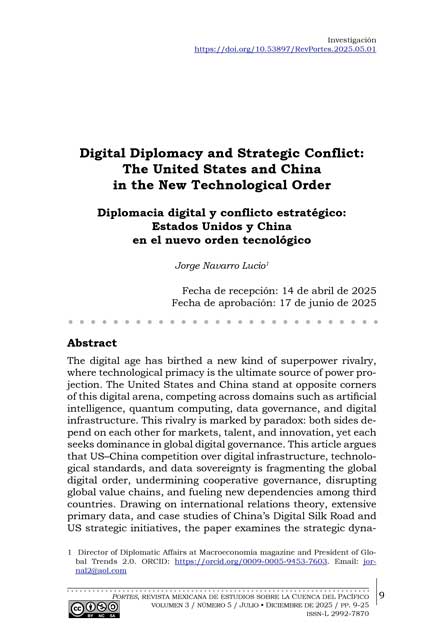Disputa diplomática digital entre Estados Unidos y China: análisis estratégico
DOI:
https://doi.org/10.53897/RevPortes.2025.05.01Palabras clave:
Digital, superpoderes, rivalidad, Estados Unidos, China, Dominación, Inteligencia Artificial, InfraestructuraResumen
La era digital ha dado a luz un nuevo tipo de rivalidad entre superpotencias. Ya no se trata de quién tiene el ejército más grande o la mayor cantidad de aliados, sino de quién da forma a la tecnología del mañana. Estados Unidos y China se encuentran en esquinas opuestas de este cuadrilátero digital. Son como dos maestros de ajedrez que juegan en varios tableros a la vez: IA, computación cuántica, control de datos e infraestructura digital. Cada movimiento repercute en el panorama tecnológico mundial. Lo que hace que este movimiento sea tan fascinante son sus contradicciones. Estos gigantes tecnológicos se necesitan mutuamente, para los mercados, la innovación y la resolución de grandes problemas como la seguridad de la IA. Pero también están enfrascados en una feroz batalla sobre cuál visión del futuro digital ganará. Un lado cree en el poder de los mercados y en el genio individual. El otro ve la tecnología como un proyecto nacional, guiado por la mano del Estado. Es 2025 y el juego sigue abierto. Las viejas reglas de las relaciones internacionales ya no encajan del todo. En cambio, estamos viendo el nacimiento de un nuevo tipo de competencia, una que dará forma a la manera en que miles de millones de personas viven, trabajan y se conectan en las décadas venideras.
Descargas
Métricas
Citas
Arciniegas, R. I., Quimbre, F., Van Soest, H. & Krovetz, A. (2024, January 16). The U.S. Must Close the Long-Distance Power Transmission Gap with China. RAND Corporation. https://www.rand.org/pubs/commentary/2024/01/the-us-must-close-the-long-distance-power-transmission.html
Bao, A. (2025, March 26). U.S. blacklists over 50 Chinese companies in bid to curb Beijing’s AI, chip capabilities. CNBC. https://www.cnbc.com/2025/03/26/us-blacklists-50-chinese-companies-in-bid-to-curb-beijings-ai-chip-capabilities.html
Barna, S., Cassidy, S. B., Ryan Burnette, R., & Brown, C. (2025, February 14). FY2025 NDAA: Congressional Efforts to Bolster U.S. Resilience Against Chinese Tech and Influence. Covington. https://www.insidegovernmentcontracts.com/2025/02/fy2025-ndaa-congressional-efforts-to-bolster-u-s-resilience-against-chinese-tech-and-influence/
Chatham House. (2024). The Future of Digital Governance: US-China Rivalry and the Global South. Chatham House.
CrowdStrike. (2025, February 27). 2025 CrowdStrike Global Threat Report: China’s Cyber Espionage Surges 150% with Increasingly Aggressive Tactics, Weaponization of AI-powered Deception Rises. CrowdStrike. https://ir.crowdstrike.com/news-releases/news-release-details/2025-crowdstrike-global-threat-report-chinas-cyber-espionage
DUCATUS Partners. (2018, August 9). Engineering a Crisis: What Human Capital Shortages Mean for American Infrastructure. Ducatus Partners. https://ducatuspartners.com/viewpoint/engineering-a-crisis-what-human-capital-shortages-mean-for-american-infrastructure
Farrell, H., & Newman, A. (2019). Of Privacy and Power: The Transatlantic Struggle over Freedom and Security. Princeton University Press. https://doi.org/10.1515/9780691189956
Harrell, P. (2025, January 30). Managing the Risks of China’s Access to U.S. Data and Control of Software and Connected Technology. Carnegie Endowment for International Peace. https://carnegieendowment.org/research/2025/01/managing-the-risks-of-chinas-access-to-us-data-and-control-of-software-and-connected-technology?lang=en
International Telecommunication Union (2023). Measuring digital development: Facts and figures 2023 (Report No. D-IND-SDDT_ASP-2025). https://www.itu.int/itu-d/reports/statistics/wp-content/uploads/sites/5/2023/11/Measuring-digital-development-Facts-and-figures-2023-E.pdf
Jin, E. (2025, February 18). A Policymaker’s Guide to China’s Technology Security Strategy. Information Technology & Innovation Foundation. https://itif.org/publications/2025/02/18/a-policymakers-guide-to-chinas-technology-security-strategy/
Keohane, R. O., & Nye, J. S. (2012). Power and Interdependence. Pearson.
Lee, R. (2025, February 5). US-China tech war: China’s computing market to outgrow US by 8X by 2029. Tech Informed. https://techinformed.com/us-china-tech-war-china-computing-growth-2029/
Li Yee, S. (2025, March 3). Containment Can’t Win the U.S.-China Tech Race Alone. Foreign Policy. https://foreignpolicy.com/2025/03/03/artificial-intelligence-ai-us-china-competition-deepseek-containment/
Martina, M., Zengerle, P., & Banco, E. (2025, March 26). China poses biggest military, cyber threat to US, intel chiefs say. Reuters. https://www.reuters.com/world/china-presents-top-military-cyber-threat-united-states-us-report-says-2025-03-25/
Organisation for Economic Co-operation and Development. (2023). Global Digital Economy Outlook. OECD Publishing.
Perlroth, N. (2021). This Is How They Tell Me the World Ends. Bloomsbury.
DLA PIPER. (2025, January 20). Data protection laws in China. DLA Piper Data. https://www.dlapiperdataprotection.com/index.html?c=CN&t=law
Pisani, N. (2025, March 11). US-China tensions: What that means for science. World Economic Forum. https://www.weforum.org/stories/2025/03/us-china-tensions-risk-setting-science-back-decades/
Polk, D. (2025, January 23). DOJ finalizes rule restricting sensitive data transfers to countries of concern, including China. Davis Polk. https://www.davispolk.com/insights/client-update/doj-finalizes-rule-restricting-sensitive-data-transfers-countries-concern
Prasad, A. S. (2025, January 15). Navigating US-China Competition and India’s Space Diplomacy in the Latin America and the Caribbean. CENJOWS. https://cenjows.in/navigating-us-china-competition-and-indias-space-diplomacy-in-the-latin-america-and-the-caribbean/
Reuters. (2025, March 26). China seen leading in chipmaking investment again in 2025, SEMI group says. Reuters. https://www.reuters.com/technology/china-seen-leading-chipmaking-investment-again-2025-semi-group-says-2025-03-26/
Schepkov, V. (2025, March 3). AI cooperation needed between US and China, says NCUSCR president. https://www.investing.com/news/stock-market-news/ai-cooperation-needed-between-us-and-china-says-ncuscr-president-93CH-3944480
SCSP. (2025). Special Competitive Studies Project. Retrieved from Who’s Ahead, Who’s Behind, and Where We Are Headed Next in the U.S.-China Technology Competition: https://www.scsp.ai/wp-content/uploads/2025/01/Gaps-Analysis-2025-Report.pdf
Thomas, M. (2025, February 11). Challenger and Incumbent Tools for U.S.-China Tech Competition. Lawfare Media. https://www.lawfaremedia.org/article/challenger-and-incumbent-tools-for-u.s.-china-tech-competition
Von Solms, R., & van Niekerk, J. (2013). From information security to cyber security. Computers & Security, 38, 97–102. https://doi.org/10.1016/j.cose.2013.04.004
Waterman, S. (2017, February 16). NATO expert: Russians have it right — it’s information security not cyber. CyberScoop. https://cyberscoop.com/nato-expert-russians-information-security-cybersecurity-election-hack-geers/
Wedell, L. (2020, July 23). Hinrich Foundation. Retrieved from China is giving ancient Silk Road trade routes a digital makeover: https://www.hinrichfoundation.com/research/article/tech/china-digital-silk-road-trade/
Wiater, D. (2025, January 14). China’s AI Soft Power Play: How Is The Digital Silk Road Shaping Global Influence? The Sundial Press. https://www.sundialpress.co/2025/01/14/chinas-ai-soft-power-play-how-is-the-digital-silk-road-shaping-global-influence/
World Bank. (2024). World Development Report: Digital Dividends https://www.worldbank.org/en/publication/wdr2024.
Zoting, S. (2025, February 15). Next Generation Computing Market Size, Share, and Trends 2025 to 2034. https://www.precedenceresearch.com/next-generation-computing-market

Descargas
Publicado
Cómo citar
Número
Sección
Licencia
Derechos de autor 2025 Jorge Navarro Lucio

Esta obra está bajo una licencia internacional Creative Commons Atribución-NoComercial-CompartirIgual 4.0.
La revista PORTES de la Universidad de Colima se distribuye bajo una Licencia Creative Commons Atribución-NoComercial-CompartirIgual 4.0 Internacional




